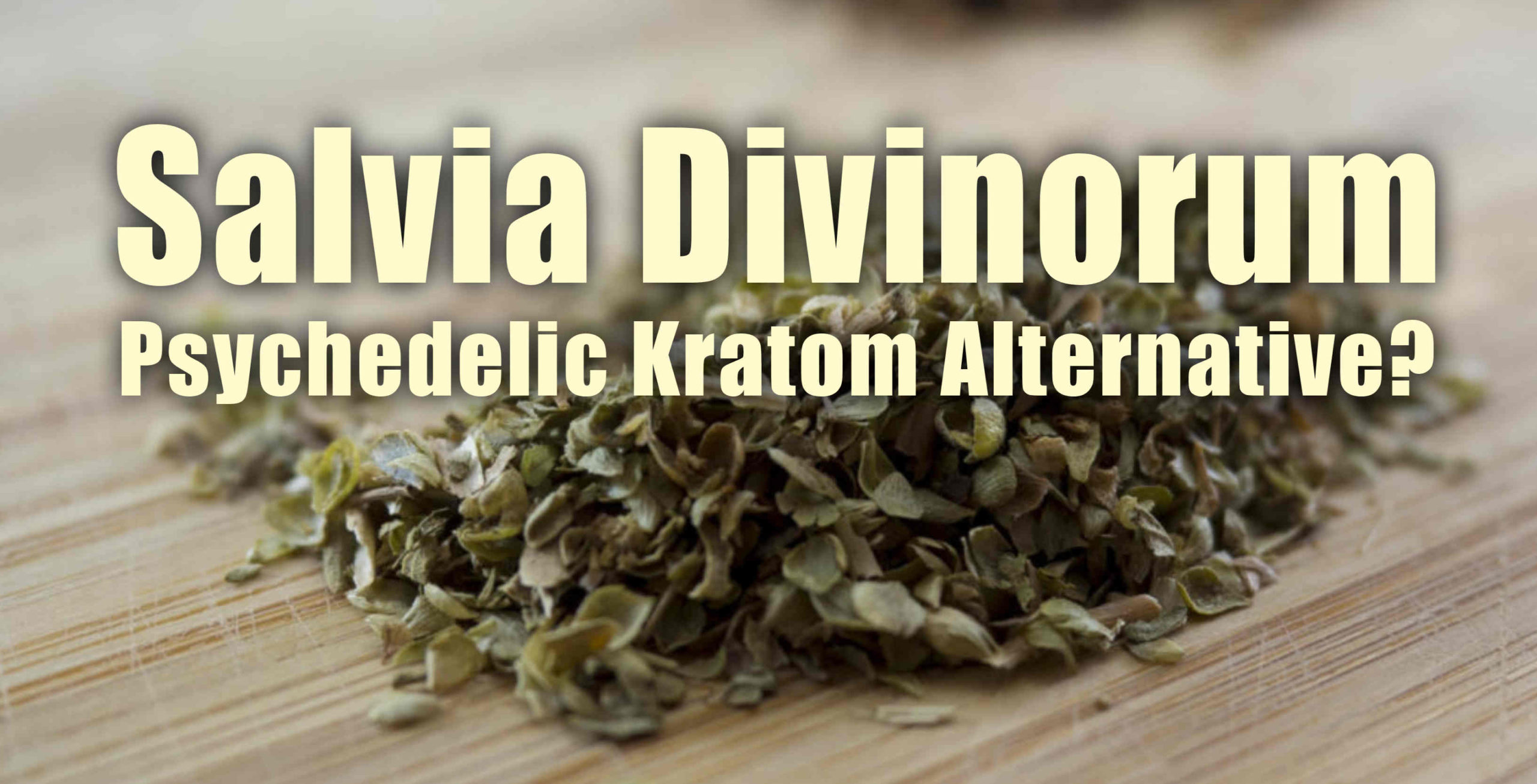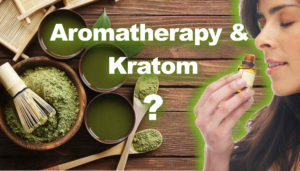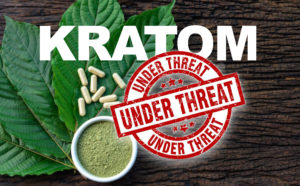If kratom was no longer available, what would you use instead?
Many choose cannabis or kava, but Salvia Divinorum may be another viable choice. It goes by such names as Diviner’s Sage, Ska Maria Pastorum, Magic Mint, Sally-D, Seer’s Sage, Shepherdess’s Herb, Lady Sally, Purple Sticky, and Incense Special.
Salvia Divinorum is a mildly hallucinogenic, pain relieving plant, with salvinorin A as the chemical causing psychoactive effects. It is a beautiful, but hard to care for perennial herb in the Labiatae (mint) family of botanical specimens. And it appears to have no physically adverse effects on otherwise healthy people.
Its leaves are chewed or brewed in a tea (never smoked). Salvia Divinorum has traditionally been used by Mazatec shamans of Oaxaca, Mexico for divining answers, discovering esoteric knowledge, foretelling the future, and in healing ceremonies, similar to how they use psilocybe mushrooms and morning glory seeds.
According to a report from the National Institutes of Health, it can be used effectively by those who suffer pain and anxiety.
https://www.ncbi.nlm.nih.gov/pmc/articles/PMC6434906/
QUOTE
Salvia divinorumcan be used as an alternative therapy for inflammatory and neuropathic pain, due in part to the presence of salvinorin A, a powerful KOR agonist and an allosteric modulator of CB1 receptors.
The experimental evidence supports the fact that S. divinorum, SA, and their analogues decrease the pain induced by neuropathy and inflammation. Moreover, the fact that Salvia divinorum administration does not increase the release of dopamine in the Nacc suggests that salvinorins and their analogues can be a suitable therapeutic alternative without the risk of producing addiction.
Long-lasting pain has been among the major therapeutic challenges of the 21st century due to its disabling effects, especially with the growing population of the elderly. In this regard, finding new molecules or associations to decrease or alleviate pain is of utmost importance.
END QUOTE
The Mazatecs of Mexico are very secretive about their shamanism. Their cultic practices and herbal lore remain mysterious and shrouded from both public view and scientific researchers.
As the corrupt FDA continues its anti-science, Big Pharma led persecution of kratom, we keep looking for possible natural alternatives to mitragyna speciosa (kratom’s botanical name). There are many plants that are said to have analgesic (pain killing) properties.
Unfortunately, the situation is rather similar to cannabis. Many plants are mentioned as “like marihuana”, but very few of them live up to that claim. No, kratom and cannabis are pretty special and there is probably nothing quite like them in nature.
However, researching substitutes for our favorite herbs can be a rewarding pursuit and new plants can be found to be helpful.
According to Sage Wisdom website:
http://sagewisdom.org/valdes83.html
QUOTE
S. divinorum is one of several vision-inducing plants employed by the Mazatec Indians, one of the native peoples living in the mountains and upland valleys of northeastern Oaxaca. Unlike other Mexican tribes, there is little information concerning their existence before the arrival of the conquering Spanish, who reduced the Mazatecan population through exploitation and disease.
This sage has been found only in forest ravines and other moist humid areas of the Sierra Mazateca between 750 m and 1500 m altitude. Carl Epling, who first described S. divinorum, reported the flower as having a blue corolla, and it has been illustrated this way in the literature. However, this description has been shown to be an error, as all living specimens of the plant have had blossoms with white corollas and purple calyces.
Mazatecan ritual use of hallucinogens, such as mushroom containing psilocybin and morning glory seeds containing lysergic acid amide, has been widely publicized through the investigations of R. Gordon Wasson and Albert Hofmann, among others.
Although the use of the mushrooms and morning glories was documented by the Spanish conquistadores and chroniclers who arrived in Mexico during the 16th Century, the literature on S. divinorum is relatively recent. Wasson originally proposed that this Salvia was the plant known to the Spanish by the Nahuatl (Aztec) name of pipiltzintzintli, but new investigations suggest that the Mexican name probably refers to Cannabis sativa L.
There are a number of common names for S. divinorum and nearly all are related to the plant’s association with the Virgin Mary. It is known to the Mazatecs as ska María or ska Pastora and the sage is also known by a number of Spanish names including hojas de María, hojas de la Pastora, hierba (yerba) María or la María. The Mazatecs believe this Salvia to be an incarnation of the Virgin Mary, and care is taken to avoid trampling on or damaging it when picking the leaves, which are used both for curing and in divination .
On a field trip in 1938, Weitlaner’s future son-in-law, the American anthropologist, Jean B. Johnson learned that the Mazatecs employed a “tea” made from the beaten leaves of a “hierba Maria” for divination.
The preparation was used in a manner similar to the “narcotic” mushrooms and the semillas de la Virgen, which were later identified as morning glory seeds (Johnson, 1939). Blas P. Reko, who knew Weitlaner well, referred to a “magic plant” employed by the Cuicatec and Mazatec Indians to produce visions. It was known as the hoja de adivinación (leaf of prophecy) and although Reko could not identify the plant, it was probably S. divinorum.
….For use in “curing” the foliage was rubbed between the hands and an infusion of from 50 to 100 leaves was prepared, the higher dose being used for alcohol “addicts”. Around midnight the curandero, the patient and another person went to a dark quiet place (perhaps a house) where the patient ingested the potion.
After about 15 min the effects became noticeable. The subject would go into a semi-delirious trance and from his speech the curandero made a diagnosis and then ended the session by bathing the patient in a portion of the infusion that had been set aside. The bath supposedly ended the intoxicated state. In addition to such “curing”, the yerba María also served for divination the culprit who was guilty of robbery or loss.
Wasson was the first to personally describe the effects of ska Pastora, relating the experiences he and member of his party had on ingestion of different doses of a beverage prepared from the plant’s foliage. At a session in July 1961 in which he participated, a curandera (female shamans are very common among the Mazatecs and other Mexican peoples) squeezed the juice of 34 pairs of leaves by hand into a glass and added water.
Wasson drank the dark fluid and wrote that although the effects came on much faster than those of the mushrooms, they lasted a much shorter time. He saw only “dancing colors in elaborate, three-dimensional designs”. Summing up the experience, he later stated: “A number of us (including me) had tried the infusion of the leaves and we thought we experienced something, though much weaker than the Psilocybe species of mushroom.”
Hofmann and his wife, Anita, who accompanied Wasson on an expedition the following year, took an infusion prepared from five and three pairs of S. divinorum leaves, respectively. Mrs. Hofmann “saw striking, brightly bordered images” while Hofmann found himself “in a state of mental sensitivity and intense experience, which, however, was not accompanied by hallucinations”.
José Luis Díaz and his coworkers studied the use of ska María Pastora in the Mazatec highlands during the 1970’s. Díaz himself took the Salvia infusion under the supervision of a shaman, Doña J., on six different occasions, noting an increased awareness of the plant’s effects each time.
The first changes he perceived were a series of complex and slowly changing visual patterns that occurred only in complete quiet with closed eyes. There were no colored geometric patterns which characteristically occur with ingestion of other hallucinogens nor were there auditory images. After a short time he noticed peripheral phenomena, such as a feeling of lightness in the extremities and odd sensations in the joints.
The climax of effects, accompanied by dizziness or nausea (mareo), lasted about 10 min and disappeared about 30 minutes after ingestion of the infusion. Other, more subtle, effects seemed to persist for a few hours.
Ska María Pastora or Salvia Divinorum is, pharmacologically, the weakest of the three hallucinogenic plants used by the Mazatecs. Following its ingestion the Virgin Mary is supposed to speak to the individual, but only in absolute quiet and darkness. The relatively mild experience is readily terminated by noise (such as a loud voice) or light.
….From the shaman the investigators learned that the plant could be used as a “medicine” as well as for the induction of visions. A low dose serves as what the investigators interpreted to be a “tonic ” or “panacea” as well as for “magical” healing (Don Alejandro did not use such terms).
An infusion prepared from 4 or 5 pairs of fresh or dry leaves may be taken by the glass (vaso) or tablespoonful (cucharada) as needed. It is used to cure the following “illnesses”, although there may be other possible uses:
- It helps one defecate and urinate. It stops diarrhea (thus, the plant apparently is believed to regulate eliminatory functions).
- It is given to the sick, old or dying to revive them oralleviate their illness. People who are pale, white and almost ready to die (they have “anemia”) may recuperate on taking la María.
- It may be taken to relieve headaches and rheumatism (however, when taken in the high doses that induce visions, it often leaves one with a headache the following morning, according to the curandero).
- There is a semi-magical disease known as panzon de barrego, or a swollen belly, which is supposedly caused by a curse from a brujo, or evil sorcerer. The victim’s midsection swells up due to a “stone” that has been put inside them. Taking the Salvia causes elimination of this “stone” and the belly shrinks down to size. The researchers met an old shaman who showed them his wrinkled middle and said he had cured himself of the “disease” by the use of “la María“. Don Alejandro confirmed the “illness” and the “cure”.
END QUOTE
READ MORE:
http://sagewisdom.org/earlysdhistory.html














